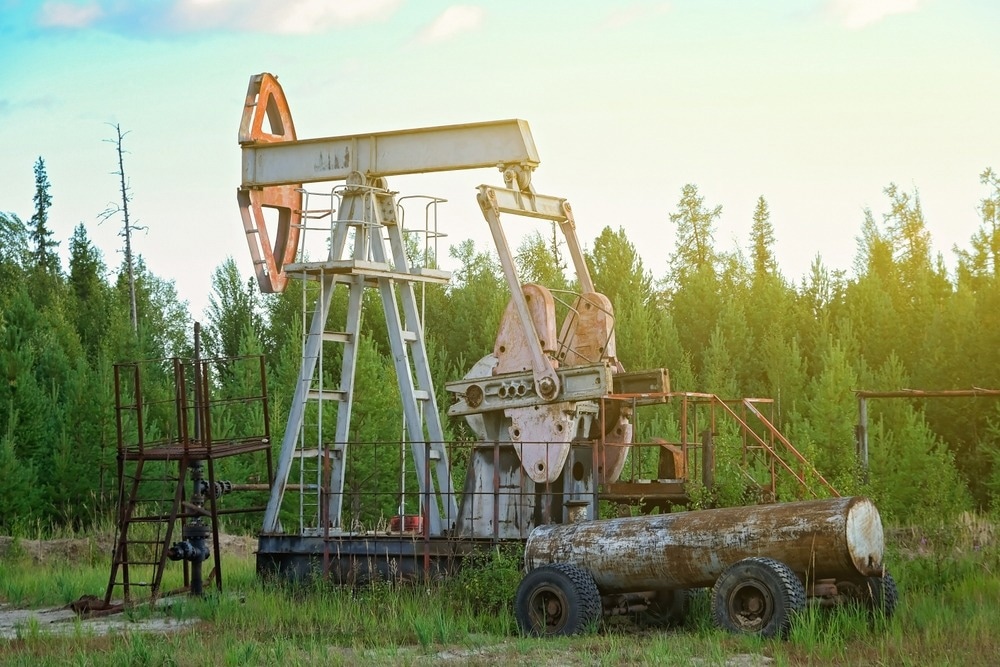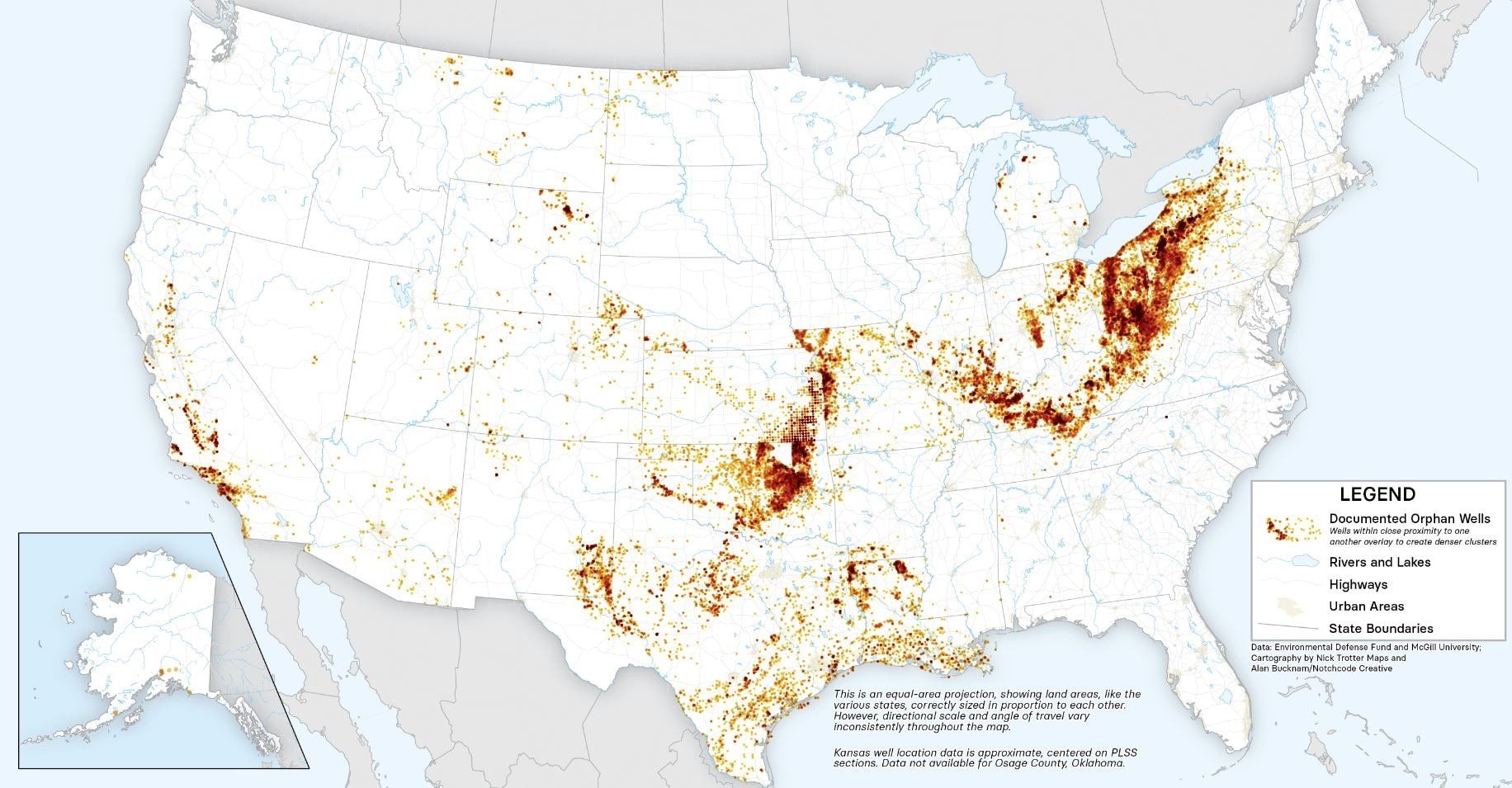After an oil or natural gas well in the United States has run dry, operators are legally required to seal the well so that it does not release toxic chemicals into the air, water, or soil. Unfortunately, there are tens of thousands of uncapped, disused oil wells with no solvent owner of record. These are commonly referred to as “orphaned wells.”

Image Credit: Olya Detry/Shutterstock.com
Orphaned wells present substantial threats to humans and the environment. The chemicals they release can contribute to climate change, contaminate groundwater, and toxify soil. Some orphaned wells are underwater, which presents a whole other set of challenges and risks. Fortunately, several tools and initiatives are designed to address the issue of orphaned wells.
According to the nonprofit Environmental Defense Fund, more than two million inactive, unplugged wells in the United States, which includes orphaned wells, release methane with the greenhouse gas equivalent of 7 to 20 million metric tons per year of carbon dioxide. Unplugged wells can also seriously hamper real estate activities, with a report by the Pittsburgh Post-Gazette indicating half of the expected building development in areas near an unplugged well.
A Technical Approach to Locating and Monitoring Orphaned Wells
Emissions monitoring company ABB sells many of its products to oil and gas businesses to detect leaks. Through a collaboration with industrial equipment supplier Winn-Marion, ABB has recently launched a wide-ranging approach to identify, describe, and monitor orphaned wells based on ABB’s gas leak and flow detection products, which are widely used in thousands of industrial plants around the globe.
ABB’s technology in this area has been fully audited by the federal Bureau of Land Management, which makes it well-qualified to address the issue of orphaned wells.
Vehicles, drone, or human investigators take high-sensitivity analyzers from ABB into the field to locate orphaned wells. These analyzers can detect methane emissions as low as 1 part per billion (ppb), with flows as low as 180 kg/h.
Measurements are tracked and logged on system computers. This methodology is based on ABB’s cost-effective SensyMaster technology that offers accurate and dynamic flow measurements of gases under low and medium pressures.
This industry-standard hardware combines thermal sensors with exceptional stability for superior performance and dependability.
The system software provides the capability to modify parameters and create novel applications. Even after a well is plugged, the technology can continue monitoring methane emissions.
The Well Done Foundation is a nonprofit using this technology from ABB to plug orphan oil and gas wells, then continue to monitor them for greenhouse gas emissions. The foundation began as a pilot project in northern Montana designed to develop a scalable model for plugging orphaned wells, and it has since expanded into many of the legacy oil states like Louisiana and Pennsylvania.
In the foundation’s recent Bear Run project, an undocumented orphaned natural gas well was found just 15 feet from an occupied mobile home.
After detecting that the well was leaking significant amounts of methane, the foundation worked with the landowner and the Pennsylvania Department of Environmental Protection to take responsibility for the well, and the well was plugged in February 2023.
Many research efforts have been measuring emissions from abandoned wells using technology from Thermo Fisher Scientific, such as the company’s MAX-iR FTIR Gas Analyzer.
The company is dedicated to combating climate change by decreasing emissions. One study published in the Geophysical Research Letters journal used Thermo Fisher technology to gauge regional methane emissions from unplugged, abandoned oil and gas wells.
The Effort to Find and Fix Orphaned Wells
Although technology holds significant promise for addressing the issue of orphaned wells, the scale of the problem is unknown.
Orphaned wells can be located on private, tribal, state, or federal lands. According to the Interstate Oil and Gas Compact Commission, there may be as many as 800,000 undocumented orphaned wells. The US Geological Survey recently released a dataset including more than 117,000 orphaned wells, while a map from the Environmental Defense Fund has more than 120,000 orphaned wells. Both datasets suggest that we know about less than one-quarter of all the orphaned wells out there.

Map of more than 120,000 documented orphan wells eligible for closure funding. Data: Environmental Defense Fund and McGill University / Cartography: Nick Trotter Maps and Alan Bucknam/Notchcode Creative
Locating these wells is only half the battle. The average cost of plugging it well is $75,000, but some walls cost more than $1 million. The state, federal, and tribal agencies responsible for remediating these wells often do not have the necessary funds.
Financial help appears to be on the way thanks to the REGROW Act, which was passed as part of the Infrastructure Investment and Jobs Act passed in 2021. The REGROW Act set aside $4.7 billion for plugging orphaned wells, and $560 million have already been distributed. In October 2021, the Environmental Defense Fund reported on the first wells to be plugged, thanks to the REGROW Act.
As known wells are being plugged, states are updating their databases to identify more orphaned wells. The current datasets indicate very dense concentrations of orphaned wells in specific areas: Appalachia, the Upper Midwest, the Mississippi Delta Region, the Western Gulf Coast, and Southern California.
These areas will likely be a main focus as the USGS works with various federal and state agencies to identify more undocumented orphaned wells. The USGS will also carry out its own surveys using magnetic imaging and lidar technologies that can detect potential well infrastructure through dense vegetation. The federal agency says it will also work to quantify the environmental impact of orphaned wells, including groundwater contamination and greenhouse gas emissions.
References and Further Reading
ABB. (2023, April 20). ABB technology to help tackle methane leakages from orphan oil and gas wells. https://new.abb.com/news/detail/102194/abb-technology-to-help-tackle-methane-leakages-from-orphan-oil-and-gas-wells
Bipartisan Infrastructure Law Investments. (2023 July 27). Plugging the Gaps: How the USGS is working to fill in data gaps for Orphaned Oil and Gas Wells. United States Geological Survey. https://www.usgs.gov/news/featured-story/plugging-gaps-how-usgs-working-fill-data-gaps-orphaned-oil-and-gas-wells
Peltz, A. (2022 October 27) First “orphan” well plugged as federal program gains momentum, more to be done. Environmental Defense Fund Energy Exchange Blog. https://blogs.edf.org/energyexchange/2022/10/27/first-orphan-well-plugged-as-federal-program-gains-momentum-more-to-be-done/
Environmental Defense Fund. (Retrieved August 2023). Orphaned well map. https://www.edf.org/orphanwellmap
Harleman, M., Weber, J. (2021, July 18) Other Voices: Plugging abandoned wells boosts local economies. Pittsburgh Post Gazette. https://www.post-gazette.com/opinion/Op-Ed/2021/07/18/Other-Voices-Plugging-abandoned-wells-boosts-local-economies/stories/202107180012
Merril, M., Grove, C., Gianoutsos, N., Freeman, P. (2023 April 6). Analysis of the United States Documented Unplugged Orphaned Oil and Gas Well Dataset. Data Report 1167. https://pubs.er.usgs.gov/publication/dr1167/full
Thermo Fisher Scientific. (Retrieved August 2023). Climate. https://corporate.thermofisher.com/content/tfcorpsite/us/en/index/corporate-social-responsibility/environment/climate.html
Well Done Foundation. (Retrieved August 2023). Bear Run #001. https://welldonefoundation.org/projects/bear-run-001/
Zhang, J., Wang, Y., Zhang, H., & Wang, S. (2015). Modeling the impact of urbanization on the spatial-temporal distribution of PM2.5 in China. Geophysical Research Letters, 42(13), 5282-5290. https://doi.org/10.1002/2015GL067623
Disclaimer: The views expressed here are those of the author expressed in their private capacity and do not necessarily represent the views of AZoM.com Limited T/A AZoNetwork the owner and operator of this website. This disclaimer forms part of the Terms and conditions of use of this website.